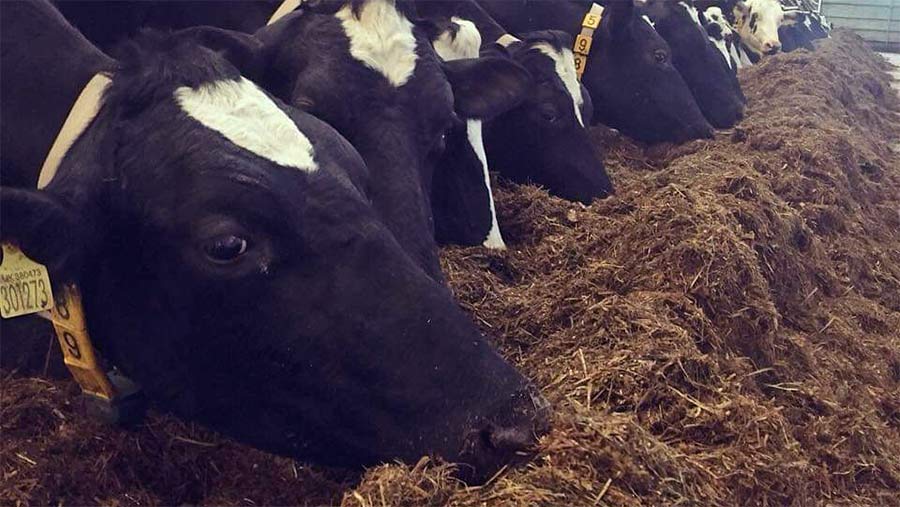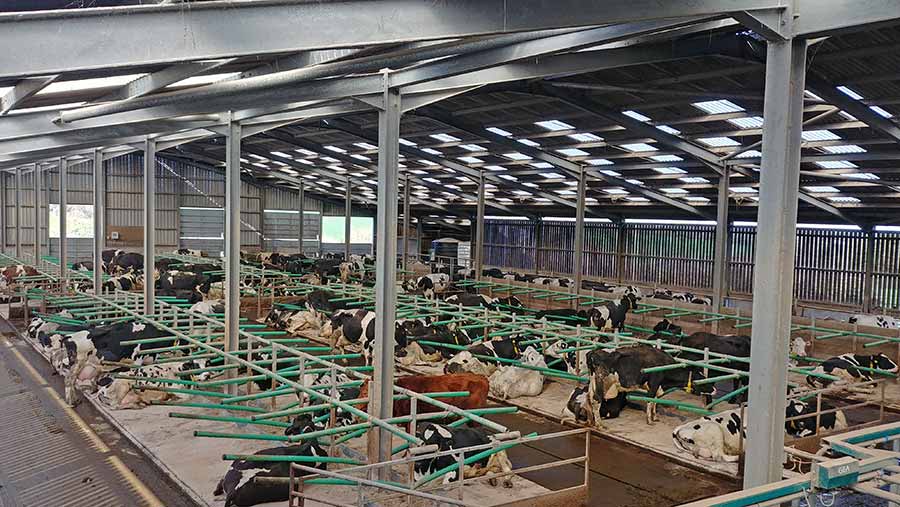Advice on lighting dairy sheds to lift milk production

From feed sources to cow comfort, there are number of factors which influence milk production in dairy cattle.
Among them is lighting, which – when designed properly – is said to be able to increase milk production by 6-10%.
Below, Farmers Weekly looks at why lighting can make a difference, what is available on the market and the key things to consider when it comes to new lighting design.
How lighting improves milk output
Theory:
Milk output and feed intake of lactating cows increases with extended periods of lighting in dairy sheds.
Evidence:
Research has shown that milk production is at its highest when there are light periods of 16 to 18 hours a day at levels of at least 160-200 lux.
According to Phil Elkins, director at Westpoint Veterinary Group, prolonged light periods are thought to increase the release of prolactin – the hormone responsible for milk production.
“Studies have shown that during lactation – particularly the early stage – a photo period of 16 hours and eight hours of dimmer lighting will lift milk production by two litres a day compared with herds that are exposed to only 13 hours of light a day.”
See also: How to improve milk yields by focusing on lighting and ventilation
Interestingly, in the dry period this is reversed. “At this stage, a short photo period is best with a recommended eight hours light and 16 hours of darker time,” he says.
For this to be achieved, high quality, consistent lighting is required. “For the high light hours, dairy farmers should look to achieve lux levels of 180-200 uniformly through the shed. In the darker periods, this can drop to as low as 50 lux or below.”
Lighting design checklist
The number of lights needed will be determined by the wattage and type of light, and the overall lighting level required.
According to AHDB Dairy, when designing a new lighting system in a dairy shed, it is worth considering the following points:
- What is the main purpose of the lighting? Think about how it will be used on a day-to-day basis and where the most appropriate places for switches are.
- For ease of use, position lights to allow them to be easily cleaned and for bulbs to be changed safely.
- Grouping and switching the lights in banks can provide different lighting levels.
- Think about the reflectivity of walls and roof material – white or light-coloured surfaces can dramatically increase lighting levels.
- Ensure you select robust waterproof and dustproof fittings.
What’s on the market? |
|||
|
Type of lighting |
How it works |
Life expectancy |
Benefits |
|
LED |
An LED is a semi-conductor light source that emits light when an electrical current flows through it. |
60,000 hours |
Low energy consumption, superior quality of light and long lasting. |
|
High-pressure sodium |
Commonly used in street lighting. They work by creating an electric arc through vaporised sodium metal and give out an orange light. |
20,000 hours |
Good efficiency, better bulb life than low-pressure sodium lamps and lower cost than LED lights. |
|
Metal halide |
Similar technology to high-pressure sodium but emit white light. |
10,000 hours |
Good efficiency, lower cost compared with LED lights. |
Case study: James Bruna, Cornwall
Farm facts
South Alston farm, Callington, Cornwall

James Bruna’s new dairy shed
- 202ha
- 220 Holstein cows
- Milking on average three times a day through four robots
- Yield 10,000 litres a cow a year
- Milk sold to Trewithen Dairy on a processing contract (paid on solids)
- All-year-round calving
- Calving index – 400 days
- Breeding own replacements
Farming 202ha near Callington, west of Dartmoor, James Bruna used the building of modern dairy facilities as an opportunity to design a whole new lighting system.
“Four years ago, we put up a brand-new shed to accommodate the installation of four robots,” he explains. “Before, we had a very old steel frame shed and the lighting was extremely poor, so we knew we had to consider this in the new design.”
Seeking advice from both the robot manufacturers and his vets, Mr Bruna installed a number of new lighting features which have improved both milk production and cow comfort.
Lighting includes:
- A single feed passage which is lit via fifteen 10-watt LED lights mounted on the steelwork above the passage.
- A photo sensor which means the lights come on automatically as it gets dark.
- Eight low-level lights have been installed down the middle of the shed, above the six rows of cubicles.
- In addition, the design incorporates 30% Perspex roof panels to bring in natural light.
Extended periods of daylight should of course be balanced with periods of darkness. However, it is crucial to ensure this doesn’t inhibit normal cow movement and behaviour. To ensure this, Mr Bruna opted for a darker area in the shed.
“We were concerned about production issues if we had complete darkness so instead, we opted for a lower-lit area that provided sufficient darkness but still allowed cows to move freely.”
Benefits
While the move to a new shed and a new milking system has obviously influenced production and cow comfort, the implementation of a thought-out lighting design has also played an influential role.
He has added 2,000 litres a cow a lactation, taking the herd’s yield average to 10,000 litres.
Mr Bruna also made an interesting discovery in the lighting of the dry cow facilities. “Our vet recommended turning the lights off completely in the dry cow shed to try and accommodate natural surroundings and instinct when it comes to calving.
“This does seem to have made a difference and we’ve intervened with very few calvings this year.”
Costings
While spending extra on lighting might seem like an extravagance, it doesn’t have to be expensive, Mr Bruna says.
“Given that our lights were all going to be used inside the shed, we used a domestic electrician, which helped bring the cost down. The LED lights on the feed passage came in at around £12 each, and the bigger ones in the main shed roof cost £100 each.”
He says the only downside of extending daylight hours is more frequent changing of bulbs. “Overall, we’re pleased with what we have done.
“Though it’s hard to monitor the direct impact, things are much better than they previously were in the old unit which is great for both us and the herd.”
